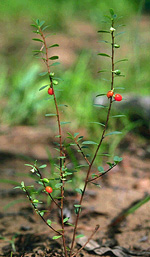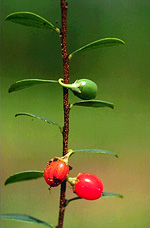 |
This small family is found throughout the tropics of the world, but is not well represented in Australia. A few species of one genus, Erythroxylum, are found in rain forests and monsoon forests of north Queensland and the Top End of the Northern Territory.
Characteristic features of the family Erythroxylaceae in Australia include: - trees or shrubs with alternate, simple leaves and stipules lying between petiole and stem
- flowers small, regular, in axillary, umbel-like clusters, with 5 free sepals and petals, the petals with strap-shaped appendages
- stamens 10, joined at the base into a short tube
- fruit a drupe
Description
Evergreen trees or shrubs. Internal secretions not obvious. Plants glabrous. Leaves alternate and spiral, petiolate. Stipules interpetiolar, bristle-like, falling off early or persistent. Lamina simple, symmetric, elliptic, oblanceolate, obovate or oblong; base cuneate or attenuate; margins entire, ±flat; venation pinnate, with the midrib conspicuous or inconspicuous, and the tertiary venation not reticulate; surfaces not punctate; herbaceous. All the flowers bisexual. Inflorescences axillary, consisting of solitary flowers or apparently of umbels. Bracts present. Bracteoles present or absent. Flowers odourless, stalked. Perianth regular, of 2 dissimilar whorls. Calyx segments free or fused, with 5 sepals or lobes, imbricate or valvate in bud; calyx bell-shaped, herbaceous. Corolla segments free, with 5 petals, alternating with the sepals or calyx lobes, imbricate in bud, cream, without contrasting markings, membranous; claws absent; lobes ±entire. Fertile stamens 10, both opposite to and alternating with the sepals or calyx lobes, free of the corolla, free of the ovary and style, fused by their filaments into an open or closed tube, all ±equal. Anthers basifixed, not versatile, opening sideways by longitudinal slits, 2-celled. Ovary superior and sessile. Carpels 3, fused; ovary with 1 or 3 locules. Style terminal, branching from the base. Ovules 1 per locule, stalked; placentation axile. Fruit a fleshy, indehiscent drupe; the perianth on the maturing fruit deciduous or dry and persistent. Disseminule micro-surface ±smooth, yellow, red, green or brown, glossy. Seeds 1 per fruit. Aril absent. Cotyledons 2. Embryo straight.
(Note: this description has been generated from the coded data compiled for the key. Any errors in the key data will be reflected in the descriptions.)
A treatment of the family Erythroxylaceae has not yet been published in the Flora of Australia. It will appear in Volume 24.
Australian genera of Erythroxylaceae (as recognised for the Flora of Australia)
Erythroxylum

|
  |

Erythroxylum sp. (fruiting plant)
Photo: S.Jacobs © S.Jacobs

Erythroxylum sp. (fruits)
Photo: S.Jacobs © S.Jacobs
|

| |